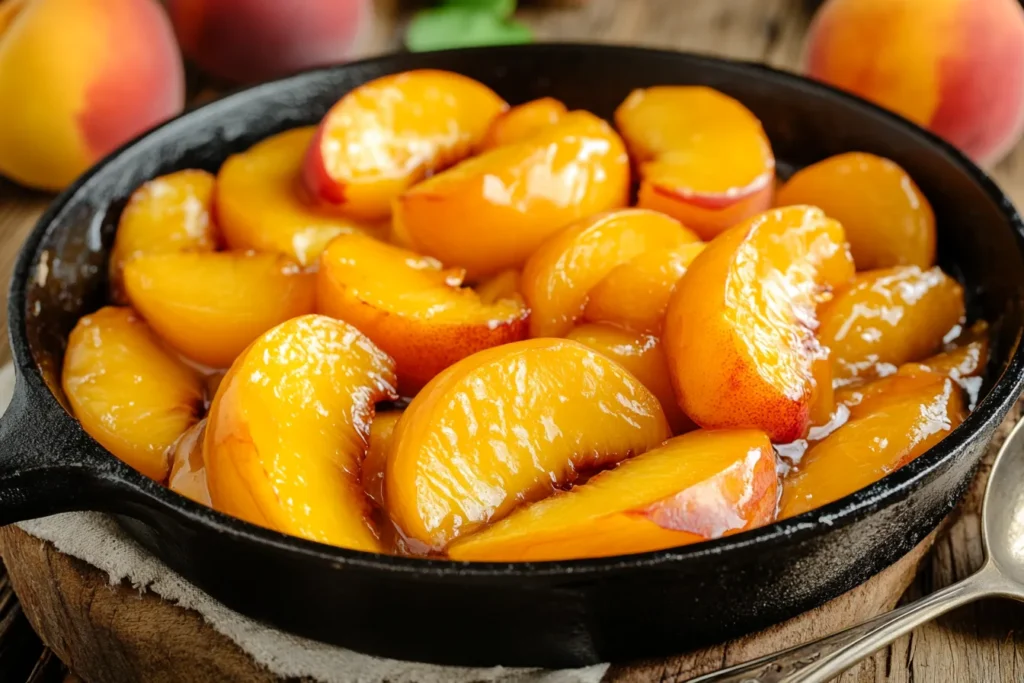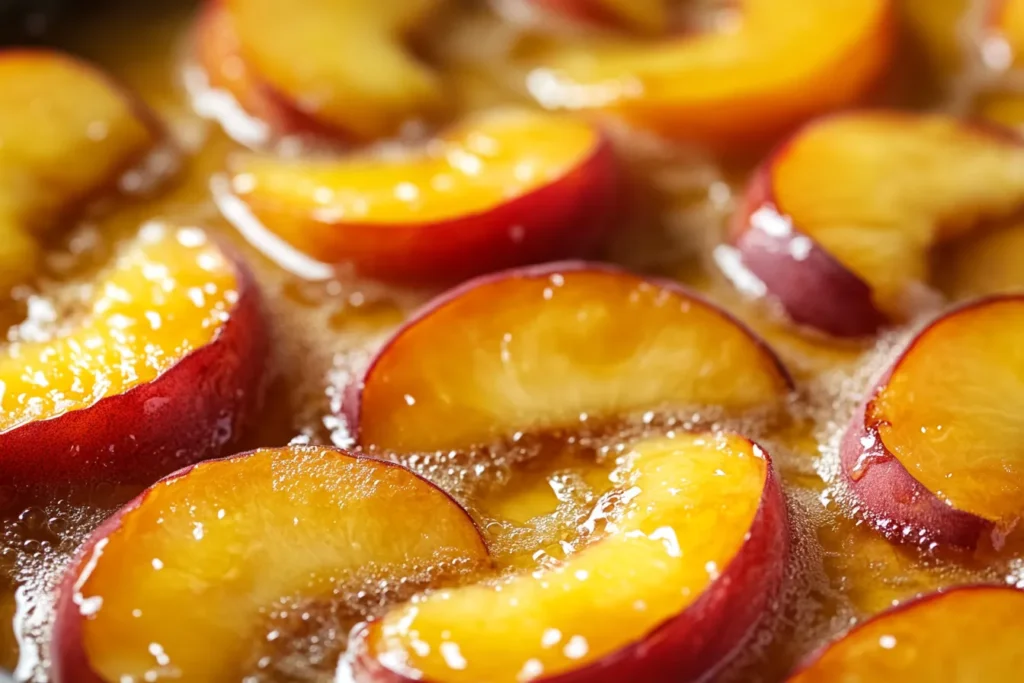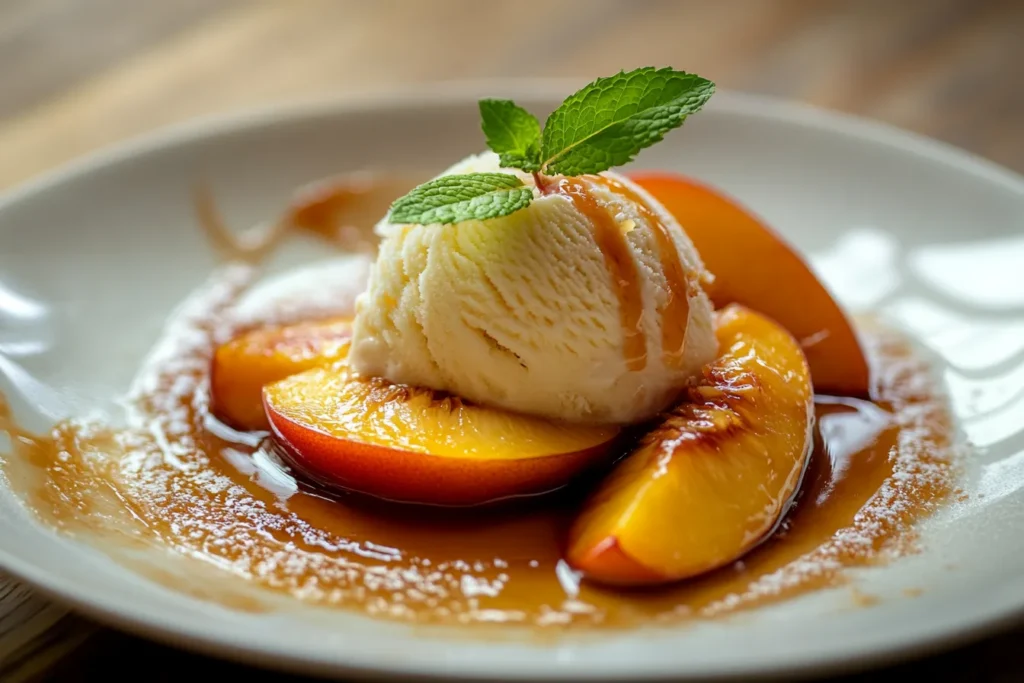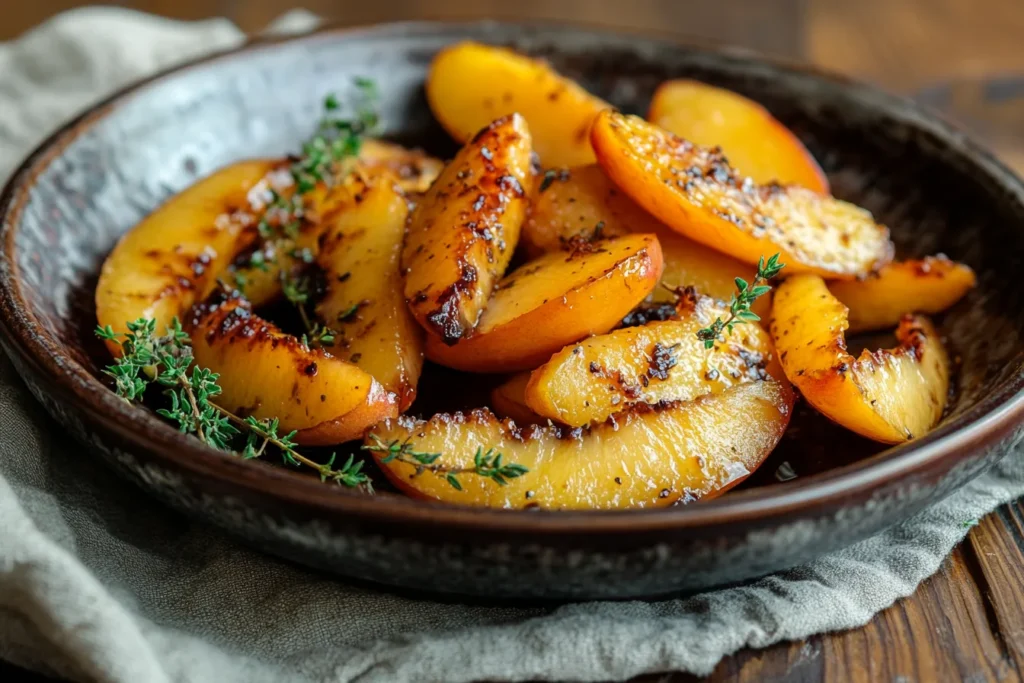Introduction
Caramelized peaches are the essence of summer on a plate—sweet, sticky, golden, and bursting with flavor. Whether you’re topping vanilla ice cream, stacking them on pancakes, or serving them as a side with grilled meats, these luscious fruits turn magical with just a touch of sugar and heat.
In this guide, we’ll explore everything about caramelized peaches—from what they are and why they’re so irresistible, to exactly how to make them perfectly at home. You’ll get detailed steps, ingredient tips, expert techniques, common mistakes to avoid, and fun serving ideas. We’ll even answer popular questions like “Can I caramelize frozen peaches?” and “What’s the healthiest way to enjoy them?”
This blog is designed with Google SEO in mind, optimized for readers searching terms like “how to caramelize peaches,” “caramelized peaches recipe,” and “peach dessert ideas.” We’ve also added internal tips, external resources, and advanced variations like honey or balsamic versions to satisfy every curiosity.
So let’s dive into the golden, glossy world of caramelized peaches—your next favorite recipe may be just a few scrolls away..Chocolate Chia Pudding Recipe
What Are Caramelized Peaches?
The Science Behind Caramelization
Caramelization is a process where sugar transforms under heat into a complex blend of nutty, toasty, and sweet flavors. When you cook peaches in sugar (with a bit of butter or oil), the natural sugars in the fruit start to break down and brown. The result? A sticky-sweet syrup and tender slices of peach that smell like sunshine.
This process begins at about 320°F (160°C) and continues as sugars deepen in color and flavor. It differs from “browning” due to Maillard reaction—which involves proteins—but both produce incredible aromas and flavor complexity.
Why Peaches Are Perfect for Caramelizing
Peaches are naturally high in sugars—especially when ripe—and that makes them ideal for caramelization. Their flesh softens without disintegrating, and their mild acidity helps balance out the sweetness of caramel. Plus, the aroma of warm peaches is instantly nostalgic and universally loved.
Freestone peaches work best because they’re easy to pit and slice, but clingstone varieties can be used too if you don’t mind a bit of extra effort..How to Mix Greek Yogurt and Protein Powder

Benefits of Caramelized Peaches
Nutritional Highlights
While caramelized peaches are a sweet treat, they still carry the nutritional benefits of fresh fruit. A single peach offers Vitamin C, fiber, potassium, and antioxidants like beta-carotene—even when cooked. Pair them with yogurt or oatmeal for a healthier combo.
Using natural sweeteners like honey or coconut sugar, or limiting butter, can make your recipe cleaner without sacrificing taste.
Versatility in Recipes
One of the best things about caramelized peaches is how versatile they are:
- Use them as a topping on French toast or waffles
- Stir them into overnight oats
- Serve with grilled pork chops or duck for a savory-sweet pairing
- Add to cocktails or mocktails for a fruity twist
- Make elegant desserts like tarts, parfaits, or shortcakes
Their caramel layer acts like a flavor shield—keeping the fruit juicy on the inside, with a rich golden exterior on the outside.
Ingredients & Tools Needed
Choosing the Best Peaches
Choose ripe but firm peaches—they should give slightly when gently pressed but not be mushy. Overripe peaches can turn too soft during cooking, while underripe ones lack sweetness.
Look for vibrant skin color (not green), smooth texture, and that wonderful peach aroma at the stem.
Sugar, Butter & Flavoring Options
- Sugar: White sugar caramelizes cleanly, but brown sugar adds deeper flavor due to molasses. Coconut sugar and maple syrup also work.
- Butter: Adds richness and helps with browning. For a vegan option, use coconut oil or vegan butter.
- Extras: Vanilla extract, cinnamon, nutmeg, and even lemon juice can enhance flavor.
Kitchen Tools That Make It Easy
- Nonstick or cast-iron skillet
- Sharp paring knife
- Wooden spoon or spatula
- Optional: tongs for flipping
You don’t need fancy gadgets, but a good pan helps achieve even heat and browning.

Step-by-Step Guide: How to Caramelize Peaches
Preparing & Slicing the Fruit
The first step to perfect caramelized peaches begins with proper preparation. Start by washing your peaches thoroughly under cold water to remove any dirt or residue. Pat them dry with a clean towel.
Next, slice the peaches. If using freestone peaches, the pit will release easily, making slicing quicker. Cut each peach in half, remove the pit, and then slice into wedges—about 6 to 8 per peach, depending on size. You want thick slices that hold their shape during cooking..Cottage Cheese Bread
You can choose to peel the peaches, but it’s optional. Leaving the skin on adds color and texture, and it softens beautifully during caramelization. However, if you prefer a smoother consistency, blanch the peaches in boiling water for 30 seconds, transfer them to an ice bath, and peel away the skin easily.
Caramelization Technique
Now, it’s time to bring the peaches to life on the stove:
- Heat Your Pan: Place a nonstick or cast-iron skillet over medium heat. Add 2 tablespoons of butter or coconut oil and let it melt fully.
- Add Sugar: Sprinkle 2 to 3 tablespoons of sugar into the pan. Let it dissolve gently into the melted butter, stirring until it forms a golden syrup.
- Add Peaches: Place the peach slices into the syrup, cut-side down. Do not overcrowd—caramelization needs space.
- Cook & Flip: Let them cook for about 3 to 4 minutes until the edges start to brown. Flip gently and cook another 2 to 3 minutes on the other side.
- Enhance Flavor: At this point, add optional flavorings like vanilla extract (½ teaspoon), ground cinnamon (a pinch), or even a splash of bourbon for a gourmet twist.
- Syrup Finish: If your peaches released a lot of juice, continue simmering for 2 more minutes until it thickens into a glaze.
Pro Tip: Stir gently to avoid breaking the fruit. You want those slices golden, tender, and just slightly sticky—not mushy or too dark.
Tips for Perfect Texture & Color
- Even Heat: Don’t crank up the heat. Medium to medium-high ensures slow caramelization without burning.
- Use a Heavy Pan: Cast iron holds heat well, creating the ideal surface for even browning.
- Dry Peaches: If the peaches are wet, they’ll steam instead of sear. Dry them thoroughly before cooking.
- Don’t Overcrowd: Cook in batches if needed. Overcrowding lowers the temperature and hinders browning.
- Taste as You Go: Some peaches are sweeter than others. Adjust sugar or lemon juice based on your taste.
Delicious Ways to Enjoy
Serving Suggestions & Pairings
Caramelized peaches are surprisingly flexible. They can go from a breakfast delight to a dinner side, and here’s how:
- With Ice Cream: Classic and indulgent. A scoop of vanilla or cinnamon ice cream over warm peaches is heavenly.
- On Pancakes or Waffles: Pour over your favorite breakfast carbs for a sweet upgrade.
- With Yogurt & Granola: Make a parfait with Greek yogurt, granola, and cooled peaches for a high-protein snack.
- Over Cheesecake: Spoon caramelized peaches onto New York cheesecake to impress guests.
As a Topping for Desserts
These peaches elevate desserts with their syrupy glaze and soft bite:
- Shortcakes: Substitute strawberries with peaches for a Southern twist.
- Crêpes: Fill warm crêpes with caramelized peaches and whipped cream.
- Tarts & Pies: Fold them into prebaked tart shells with mascarpone.
In Beverages & Savory Dishes
Caramelized peaches aren’t just for sweet dishes. They can also create unforgettable savory pairings and drinks:
- Cocktails: Muddle into bourbon or gin cocktails for a sweet-fruity note.
- Grilled Meats: Serve alongside pork chops, chicken, or duck. Their sweetness balances savory richness.
- Salads: Cool slices tossed with arugula, goat cheese, and balsamic dressing for a fresh summer salad.

Advanced Variations & Flavor Twists
Caramelized peaches are already a luxurious treat, but with a few clever twists, they can be elevated to a whole new level. Whether you’re looking for bolder flavors, healthier alternatives, or unique pairings, these variations offer something special for every palate and occasion.
Adding Balsamic or Honey
Let’s start with two of the most popular upgrades—balsamic vinegar and honey.
- Balsamic Caramelized Peaches: Once your peaches are golden and caramelized, drizzle in a tablespoon of aged balsamic vinegar. The acidity cuts through the sweetness and adds a rich, tangy depth. This variation is ideal when serving the peaches with meats, cheese boards, or savory salads. It also works well in gourmet sandwiches.
- Honey-Glazed Peaches: For a more natural sweetener, skip the granulated sugar and drizzle raw honey into the skillet after the peaches have cooked for a few minutes. Honey caramelizes quickly, so lower the heat to avoid burning. Add a touch of sea salt to enhance the contrast of flavors. This version is delightful on top of Greek yogurt or ricotta toast.
Flavor Tip: Use flavored balsamic vinegar—like fig or cherry—for a surprising twist. Similarly, infused honeys (lavender, ginger, or chili) can create gourmet flavor layers.
Infuse with Herbs or Spices
Herbs and spices can transform your peaches from basic to unforgettable. Try infusing your caramel mixture with one or more of the following:
- Thyme or Rosemary: These herbs add an earthy, savory note. Add a sprig during the cooking process and remove it before serving.
- Mint: Add chopped fresh mint after cooking for a refreshing finish.
- Cinnamon or Nutmeg: Classic warm spices that pair beautifully with peaches—especially in fall.
- Cardamom or Star Anise: For a bold, aromatic spin, especially in Indian or Middle Eastern-themed dishes.
Pro Tip: When using dry spices, add them early in the cooking process so they bloom in the hot butter or oil. For fresh herbs, toss them in at the end to retain brightness.
Caramelized Peaches for Special Diets (Vegan/Gluten-Free)
You don’t have to skip out on flavor if you’re cooking for dietary restrictions. Here’s how to make caramelized peaches work for everyone:
- Vegan Option: Replace butter with plant-based alternatives like vegan margarine, coconut oil, or avocado oil. Stick to natural sweeteners like maple syrup or agave nectar for a completely plant-based dessert.
- Gluten-Free: Good news—caramelized peaches are naturally gluten-free! Just be cautious with any toppings or sides (like cookies, waffles, or ice cream) to ensure they don’t contain hidden gluten.
- Low-Sugar Option: Use very ripe peaches, which are sweeter naturally. You can even skip added sugar and rely solely on the fruit’s sugars for caramelization. A sprinkle of cinnamon can enhance perceived sweetness without increasing sugar content.
Bonus Idea: Serve low-sugar caramelized peaches over a scoop of keto-friendly vanilla ice cream or almond-milk yogurt for a dessert that’s both delicious and mindful.
Flavor Combo Suggestion: For a unique brunch idea, serve vegan caramelized peaches with gluten-free pancakes, toasted pecans, and a drizzle of almond butter. It’s indulgent, nutrient-dense, and Instagram-worthy.

Common Mistakes & Troubleshooting
Even though caramelizing peaches is a fairly simple process, a few missteps can lead to disappointment. Burnt sugar, mushy texture, or lackluster flavor are all common pitfalls. Below, we’ll explore these issues and offer practical solutions to help you get it right every time.
Burning vs. Proper Browning
One of the most frequent mistakes is letting the sugar burn before it has time to caramelize properly. Burnt sugar turns bitter and can ruin the delicate sweetness of the peaches.
How to Avoid It:
- Control the heat: Stick to medium or medium-low heat. High heat may speed things up but often leads to scorching.
- Use a heavy-bottomed pan: Cast iron or stainless steel pans distribute heat more evenly than thin nonstick ones.
- Stay attentive: Sugar caramelizes quickly. Stir and observe closely, especially once browning begins.
Tip: If the sugar begins to smoke, remove the pan from heat immediately and start over. Burnt caramel can stick and become impossible to clean.
Under-done or Mushy Texture
If your peaches are too firm or too soft after caramelizing, the final result may not be as enjoyable. The goal is tender slices with a slight bite—not raw or overcooked.
Common Causes:
- Underripe peaches: These don’t soften well and might remain chewy or sour.
- Overripe peaches: While sweet, they break down too fast and become mush.
- Overcooking: Excessive heat or time in the pan can turn even perfect peaches into mush.
Solutions:
- Choose ripe but firm peaches that give slightly when pressed.
- Test as you go: Remove slices as they reach the right consistency. They continue to cook slightly even after being removed from heat.
- Keep slices relatively thick—thinner slices cook too fast.
Too Sweet or Insipid Flavor
Flavor balance is key. Sometimes caramelized peaches can turn out overly sweet, especially when too much sugar is used. On the flip side, peaches that are underripe or bland can lead to a dull dish.
How to Fix It:
- Add acidity: A squeeze of lemon juice or a splash of balsamic vinegar can balance out the sweetness.
- Use spices: A pinch of cinnamon, cardamom, or nutmeg adds complexity and reduces the cloying effect.
- Enhance with salt: Just a pinch of sea salt can amplify all the other flavors without making it salty.
Tip: Always taste your peach slices before cooking. If they’re naturally very sweet, reduce the amount of sugar you add.
Other Tips to Improve Every Batch
- Don’t crowd the pan: If too many slices overlap, they’ll steam instead of sear. This kills the caramelization process.
- Use the right utensils: A silicone spatula or wooden spoon helps lift the fruit without breaking it.
- Store properly: Let caramelized peaches cool, then store in an airtight container in the fridge for up to 4 days. Reheat gently to preserve texture.
Pro Kitchen Hack: If you’ve accidentally made too much syrup and the peaches are swimming in it, drain a portion and simmer it separately until it thickens, then drizzle it back over the top.
FAQ
This section answers the most frequently asked questions about caramelized peaches, helping you avoid uncertainty in the kitchen and unlock even more creative ways to enjoy this delicious treat.
Can I use frozen peaches?
Yes, you can use frozen peaches, and they work surprisingly well! The key is to thaw and drain them completely before cooking. Frozen peaches release extra moisture, which can prevent proper caramelization if added straight to the pan.
How to use them:
- Thaw in a colander for 30–45 minutes
- Pat dry with paper towels
- Cook in a hot pan to reduce excess water before adding sugar
Note: Frozen peaches are often softer than fresh ones, so be gentle when stirring to prevent breakage.
How long do caramelized peaches last?
Caramelized peaches will stay fresh in the refrigerator for 3 to 4 days when stored in an airtight container. The syrup may thicken slightly when chilled but will loosen up when reheated.
Storage tips:
- Store in glass jars or BPA-free containers
- Reheat in a skillet on low heat or microwave for 30–40 seconds
They’re excellent for meal prep and can be made ahead for brunches, desserts, or weeknight dinners.
Are caramelized peaches healthy?
Caramelized peaches can be a part of a healthy diet, especially when made with moderate sugar and healthy fats. Peaches themselves are rich in vitamins A and C, antioxidants, and fiber.
For a healthier version:
- Use coconut oil or olive oil instead of butter
- Try honey, maple syrup, or coconut sugar instead of white sugar
- Skip the syrup and cook until lightly golden
Keep in mind that portion size matters. A few caramelized peach slices with yogurt or oatmeal can be a nutritious and energizing meal component.
Can I prep caramelized peaches in advance?
Absolutely. In fact, caramelized peaches often taste even better the next day as the flavors meld together. They can be made up to 2 days in advance and stored in the fridge.
Advance prep ideas:
- Caramelize a big batch for the week ahead
- Store in single-serve containers for easy use
- Use as a base for smoothies, parfaits, or sauces
They’re perfect for entertaining, too—prepare them earlier in the day and reheat just before serving over ice cream or pancakes.
What’s the best sugar substitute?
If you’re cutting down on refined sugar, there are great natural options for sweetening:
- Maple syrup: Adds warmth and depth
- Honey: Naturally sweet and floral
- Coconut sugar: Lower glycemic index and a rich, toffee-like flavor
- Date syrup: Great for a dark, molasses-style sweetness
Note: Some sugar substitutes like stevia or monk fruit don’t caramelize well on their own. If using these, try combining them with a small amount of real sugar or syrup to achieve browning.
Can I grill peaches instead of caramelizing them in a pan?
Yes! Grilled peaches are another amazing way to bring out their natural sugars with a slightly smoky flavor. While they’re technically not “caramelized” in the traditional sense, grilling gives you similar results with added depth.
To grill peaches:
- Halve and pit the peaches
- Brush with oil or melted butter
- Grill on high heat for 2–3 minutes per side
- Drizzle with honey or syrup afterward if desired
Grilled peaches make fantastic salad toppers and pair beautifully with blue cheese or prosciutto for a savory dish.
Conclusion
Caramelized peaches are a celebration of simplicity, flavor, and seasonal joy. With just a few everyday ingredients—peaches, sugar, and butter—you can create a golden, syrupy topping or side dish that feels gourmet but comes together in minutes. Whether you’re making a quick dessert, adding flair to breakfast, or pairing fruit with savory meals, caramelized peaches are incredibly versatile and crowd-pleasing.
We’ve covered the essentials, from choosing the best peaches to nailing the caramelization process. With expert tips, tasty variations like balsamic or honey-glazed options, and health-conscious adjustments for vegan or gluten-free diets, this recipe can be personalized for any occasion or preference.
Don’t forget to experiment—add herbs, try them grilled, or serve over pancakes with whipped cream. The possibilities are as sweet as the fruit itself. Keep this guide bookmarked, and you’ll always have a go-to summer treat at your fingertips.

Name: Caramelized Peaches
Ingredients
Equipment
Method
- Instructions:
- Wash and dry the peaches. Cut them in half, remove the pit, and slice each half into 3–4 wedges. Peeling is optional.
- Heat a large skillet over medium heat. Add the butter and allow it to melt.
- Sprinkle in the sugar and stir gently to combine with the butter until it starts bubbling.
- Add the peach slices in a single layer, cut side down. Let them cook undisturbed for 3–4 minutes.
- Flip the slices and cook for another 2–3 minutes, until tender and golden.
- Add vanilla, cinnamon, or lemon juice if using. Stir gently to coat the peaches in the syrup.
- Remove from heat. Serve warm over ice cream, pancakes, yogurt, or as-is.
